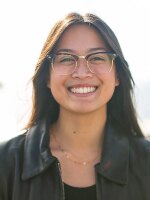Laughter and nervous chatter filled the theater during the final period before school let out.
Students gathered at Crawford High School to interview each other about democracy and their roles in it.
They had a variety of responses, ranging from excitement to timidity about the election.
Some students aren’t quite old enough to vote but are wrapping up their time in high school. Twelfth-grader Salima Mlonge’s biggest takeaway from her interview is the power of her voice.
"I liked the experience because it just made me, like, kind of open myself to share a little bit about how I feel about just the voting, the elections and just political [things] and say things in hopes of sending a message somehow," Mlonge said.
Her message will be featured in a comic book page created by her group, which included an art student, camera operator and interviewee.
Brian Black, a visual art teacher at Crawford, said teachers are trying to think of creative ways to engage students in the election.
"We wanted them to get to think about voting and registering," Black said. "I think there's a lot of graphic novels that are out now that really serve like this, this entry way into getting kids interested in reading."
In the classroom
This project at Crawford High School is a collaboration between several district departments and programs.
The Equity & Belonging Division connected with the Visual and Performing Arts Department to come up with a plan to incorporate core tenants of the SD Unified for Democracy initiative into a school project that blends the visual arts, multimedia and AP government classes.
There were about 50 students at the Crawford High School event, and the district is doing several more before the election.
The district-wide democracy effort aims to encourage education around the election season — from guest speakers in the classroom to presentations engaging parents.
According to the Center for Information and Research on Civic Learning and Engagement, roughly 8 million youth will be eligible to vote for the first time in 2024. That would make 41 million members of Gen Z eligible to vote in 2024.
Interim superintendent Fabiola Bagula said the project starts with hosting nonpartisan discussions for students and families.
"Our aspiration was civic discourse and an engaged electorate — like those were two big pieces," Bagula said. "How do we start thinking about how children can actually start engaging in that kind of talk?"
One of the ways is through comic books. Black local artist, writer and educator Neil Kendricks was invited as a guest speaker. He is the author and illustrator of an interactive comic book titled "We the People, Sing Our Song."
"I think we need to empower youth so that they see that they matter, that their stories are important and that they're part of this larger story, the American story," Kendricks said.
After school hours
Elsewhere in the district, both family members and the public gathered at Spreckels Elementary School for an event about identifying misinformation. The League of Women Voters put together the presentation.
"One of the reasons we're talking about misinformation, specifically, is to help people find tools to navigate through the sea of information out there and find solid factual information that's pretty neutral, free of bias," said Linda Frueh, a member of the San Diego League of Women Voters board of directors.
The presentation covered misinformation, disinformation and media literacy.
Veronica Prager attended the event at her son’s elementary school. She said discussing voting decisions with her son isn’t always easy.
"He asks questions, and we try to give him real answers where we say, 'Some people feel this way, but this is what we feel,'" Prager said. "We're not trying to indoctrinate him, but we're trying to give him real information so that it's not so emotionally charged."
While her son is far from voting age, at Crawford, some students are casting their vote for the first time.
Zackary Fleuret, an eleventh grader, won’t be voting age this year. But he’s hopeful for continued discussions about the election.
"I'd like to see more students having more student to student peer discussions, but not just a friend on a friend basis, on a bigger scale where we have like all the students listen to some students talk about their feelings politically or whatever," Fleuret said.
Salima Mlonge, like many soon-to-be voters, isn’t sure what will happen after the election, but she’s hoping to see a better economy and better quality of life.
"I think we're still kind of in the midst of just trying to figure out what to actually do for the future," Mlonge said.
Until her first time casting her vote, she’s grateful for a chance to have her voice heard.







